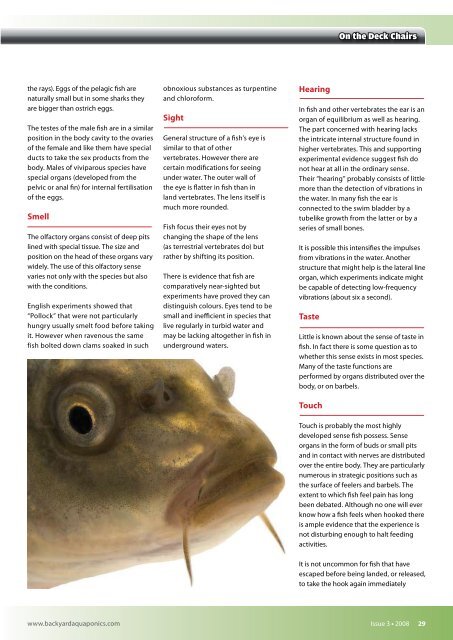Keeping Trout - Backyard Magazines
Keeping Trout - Backyard Magazines
Keeping Trout - Backyard Magazines
Create successful ePaper yourself
Turn your PDF publications into a flip-book with our unique Google optimized e-Paper software.
the rays). Eggs of the pelagic fish are<br />
naturally small but in some sharks they<br />
are bigger than ostrich eggs.<br />
The testes of the male fish are in a similar<br />
position in the body cavity to the ovaries<br />
of the female and like them have special<br />
ducts to take the sex products from the<br />
body. Males of viviparous species have<br />
special organs (developed from the<br />
pelvic or anal fin) for internal fertilisation<br />
of the eggs.<br />
Smell<br />
The olfactory organs consist of deep pits<br />
lined with special tissue. The size and<br />
position on the head of these organs vary<br />
widely. The use of this olfactory sense<br />
varies not only with the species but also<br />
with the conditions.<br />
English experiments showed that<br />
“Pollock” that were not particularly<br />
hungry usually smelt food before taking<br />
it. However when ravenous the same<br />
fish bolted down clams soaked in such<br />
www.backyardaquaponics.com<br />
obnoxious substances as turpentine<br />
and chloroform.<br />
Sight<br />
General structure of a fish’s eye is<br />
similar to that of other<br />
vertebrates. However there are<br />
certain modifications for seeing<br />
under water. The outer wall of<br />
the eye is flatter in fish than in<br />
land vertebrates. The lens itself is<br />
much more rounded.<br />
Fish focus their eyes not by<br />
changing the shape of the lens<br />
(as terrestrial vertebrates do) but<br />
rather by shifting its position.<br />
There is evidence that fish are<br />
comparatively near-sighted but<br />
experiments have proved they can<br />
distinguish colours. Eyes tend to be<br />
small and inefficient in species that<br />
live regularly in turbid water and<br />
may be lacking altogether in fish in<br />
underground waters.<br />
Hearing<br />
In fish and other vertebrates the ear is an<br />
organ of equilibrium as well as hearing.<br />
The part concerned with hearing lacks<br />
the intricate internal structure found in<br />
higher vertebrates. This and supporting<br />
experimental evidence suggest fish do<br />
not hear at all in the ordinary sense.<br />
Their “hearing” probably consists of little<br />
more than the detection of vibrations in<br />
the water. In many fish the ear is<br />
connected to the swim bladder by a<br />
tubelike growth from the latter or by a<br />
series of small bones.<br />
It is possible this intensifies the impulses<br />
from vibrations in the water. Another<br />
structure that might help is the lateral line<br />
organ, which experiments indicate might<br />
be capable of detecting low-frequency<br />
vibrations (about six a second).<br />
Taste<br />
Little is known about the sense of taste in<br />
fish. In fact there is some question as to<br />
whether this sense exists in most species.<br />
Many of the taste functions are<br />
performed by organs distributed over the<br />
body, or on barbels.<br />
Touch<br />
On the Deck Chairs<br />
Touch is probably the most highly<br />
developed sense fish possess. Sense<br />
organs in the form of buds or small pits<br />
and in contact with nerves are distributed<br />
over the entire body. They are particularly<br />
numerous in strategic positions such as<br />
the surface of feelers and barbels. The<br />
extent to which fish feel pain has long<br />
been debated. Although no one will ever<br />
know how a fish feels when hooked there<br />
is ample evidence that the experience is<br />
not disturbing enough to halt feeding<br />
activities.<br />
It is not uncommon for fish that have<br />
escaped before being landed, or released,<br />
to take the hook again immediately<br />
Issue 3 • 2008 29


